Disclosure: Meeple Mountain received a free copy of this product in exchange for an honest, unbiased review. This review is not intended to be an endorsement.
“Gimme a dozen” might be one of the best phrases in the English language.
Where else can you get 12 completely different takes on the same basic thing, in a single box, and all for around $10? Glazed, sprinkled, powdered, filled, or topped, the donut is one of America’s favorite pastries. Donuts have been enhanced by everything from blueberries to bacon, peanuts to pineapple-basil, and yet its simple elegance can often be best expressed by a simple glazed donut and a cup of joe.
The history of the pastry can be traced back to Dutch settlers in New Amsterdam (now New York City). The earliest mention of “doughnuts” came from Washington Irving’s 1809 book A History of New York from the Beginning of the World to the End of the Dutch Dynasty, while the creation of the famous ring shape was claimed by an American seaman named Hanson Gregory who poked the hole in the center of the dough with a pepper mill.
But enough with the history lesson, let’s take a look at Dollars to Donuts, a game designed by our friends from Flatout Games, illustrated by Dylan Mangini, and published by Crafty Games!
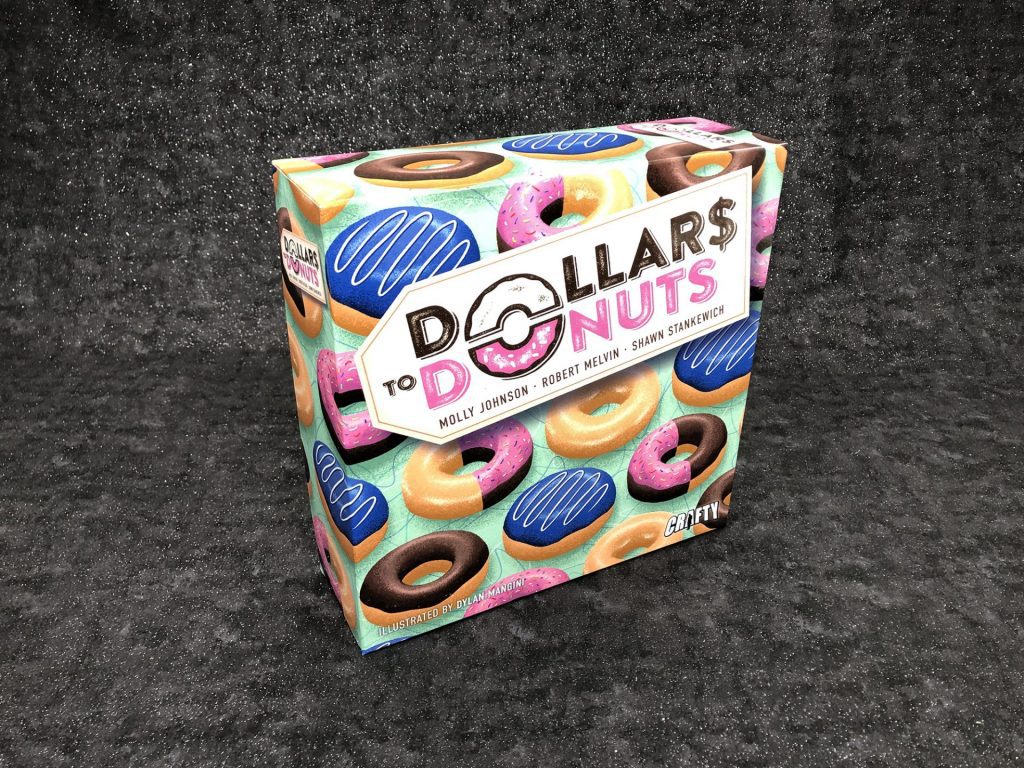
Dollars to Donuts Overview
In Dollars to Donuts players run rival donut shops, each hoping to serve the most customers and dominate the pastry business in their town. Players will buy and place tiles featuring partial donuts, assembling them in their display cases. “Perfectly matched” donuts will earn a matching Victory Token which can be served to customers or used as points at the game’s end, while “Mismatched” donuts will earn you Dollar Tiles.
While Dollars to Donuts isn’t a true polyomino game (à la Tetris, Scarabya, Blokus, or A Feast for Odin) it does include that same sort of puzzly tile-placement gameplay. The end goal is to fill as much of your personal player board as possible with donut tiles and to serve more customers than your opponents. The player who fills their board first triggers the end of the game and the player with the most points is the winner.
Setup
Set out the Specials board and place 6 long Donut tiles face up. Shuffle the Customer Cards and place 4 face up. Place the bag of Dollar Tiles nearby along with the separated Victory Tokens (which display plain, chocolate, deluxe sprinkled, and jelly-filled donuts). Each player receives their own board and 4 matching starter tiles, along with 5 Dollar tiles (4 with plain donut holes and one with chocolate donut holes). One additional note about setup: each player takes their 4 starting tiles and places them face up somewhere on their board. The only rule being that no two tiles can appear in the same row or column.
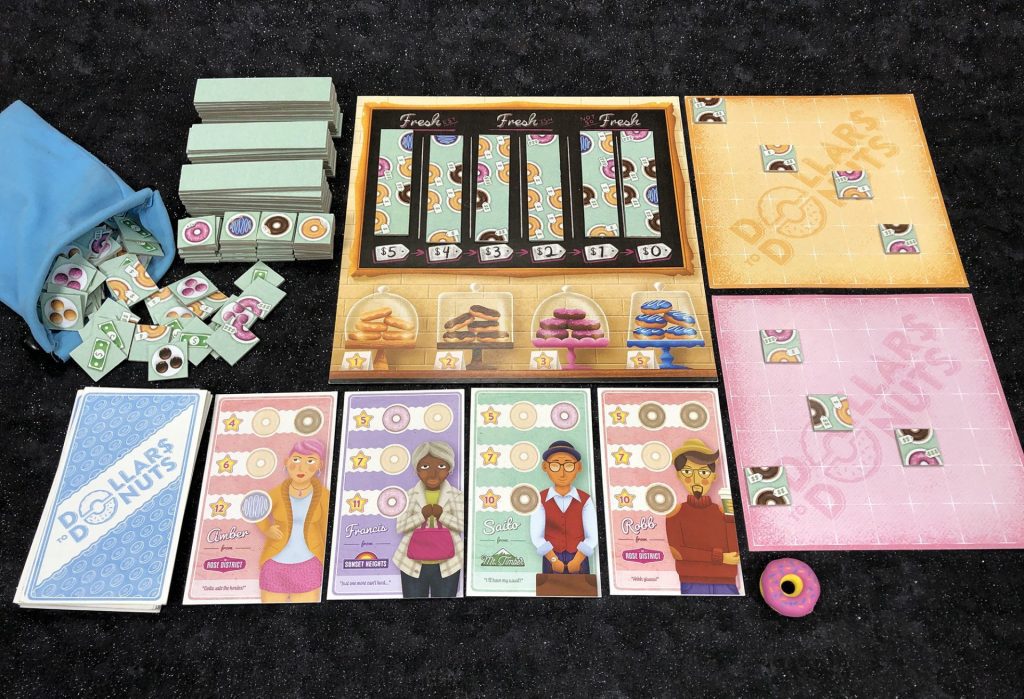
The prototype we received had a rubber donut for a first player marker. It is unknown at this time if the production copy of the game will include one. 😀
Turn Overview
Step 1: The first thing you’ll do on your turn is look at the Specials board and select a Donut tile to place onto your personal player board. The rightmost tile will always be free, while the leftmost tile costs $5. Players will use Dollar tiles to purchase the Donut tiles. Each Dollar tile acts as either money, or as filler for your player board so choose wisely as money can be tight throughout the game.
Step 2: After you select your Donut tile, place it onto your board. The goal is to form as many matched donuts as possible.
Step 3: When a perfect match is made (both halves are the same), a corresponding Victory Token is taken. Victory Tokens are worth points equal to the star level on the Specials board (1 for plain, 2 for chocolate, 3 for deluxe sprinkles, and 4 for jelly).
Step 4: Mismatched donuts (different halves) allow you to draw a number of Dollar Tiles from the bag equal to the dollar amount of the more valuable donut half.
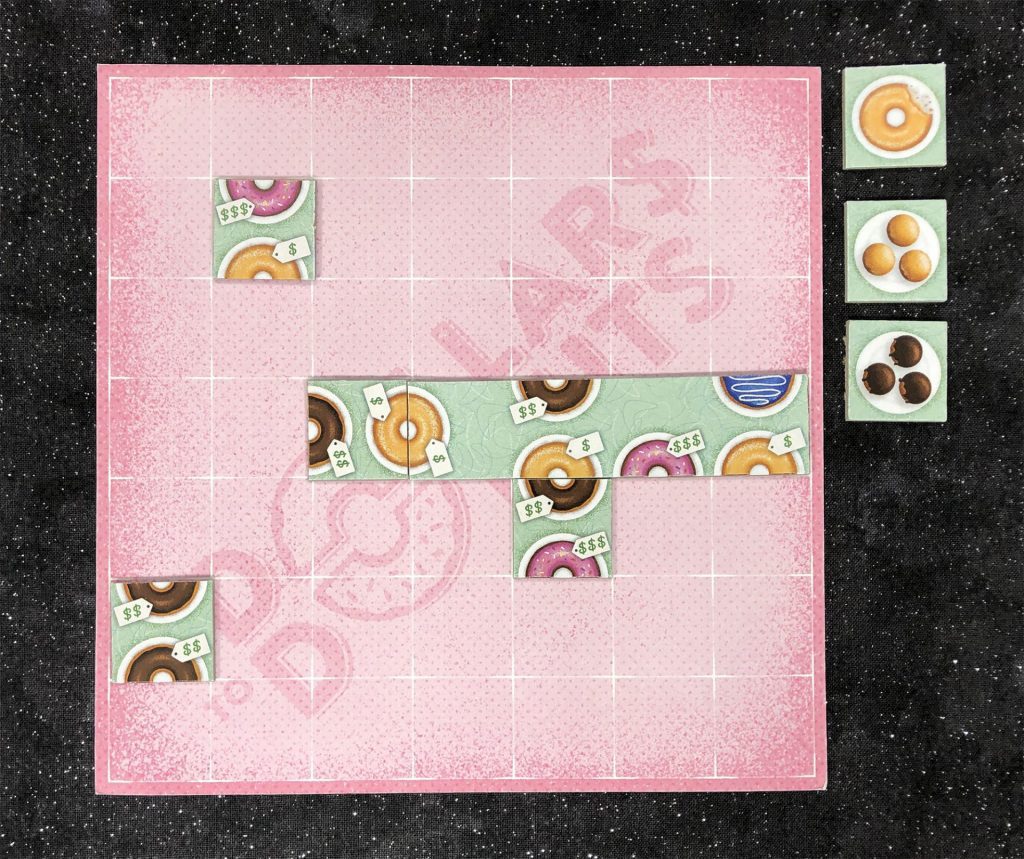
One great feature about this game is that tiles can be placed so that they extend past the borders of the player board. This is a feature I’ve not seen in other games before and it’s really helpful. Use it wisely though because you’ll lose points at the end of the game for every empty space on your board.
Step 5: Next players may place a single Dollar Tile on their board. In addition to acting as currency, the Dollar Tiles also act as filler for your player board. Some of these tiles have donut halves, while others have donut holes. The half tiles allow you to complete donuts on your board, while pairs of donut holes will earn you bonus points at the end of the game (1, 2, and 3 points for plain, chocolate, or deluxe respectively).
If placing a Dollar Tile would allow you to complete a donut, you will repeat steps 3 & 4 again, but will never repeat step 5.
Step 6: If you have enough Victory Tokens you can serve a single customer.

Each Customer card has two main points of interest: the 3 Satisfaction levels (Contented, Delighted, and Thrilled), and a neighborhood name (which also corresponds to the color of the card). When serving a customer you must always start from the top and work your way down. You must always complete the top line to be able to serve a customer but may optionally complete the second and third lines as well. A Customer card will earn you points equal to the number on the bottom most completed section of the card.
You may never go back and add donuts to a customer later.

In addition to earning the listed points on Customer cards, players can also receive bonus points for Customer cards in two other ways. Each complete set of neighborhoods (Mt. Timber, Rose District, and Sunset Heights) will earn you 3 points and the player with the majority of customers from each neighborhood will earn an additional 2 points. Customer completion levels don’t affect either of these bonuses.
Steps 7 & 8: Refill the Specials board and reveal a new Customer card (if needed).
End of the Game & Scoring
The end game is triggered when one player completely fills their player board. Play continues until every player has had the same number of turns. The game can optionally end if the Specials board cannot be refilled.
Players will score points for the following:
- Served customers
- Neighborhood bonuses (sets and majority)
- Pairs of donut holes
- Remaining Victory Tokens
- Subtract 1 point for every empty space on your board.
The player with the most points wins the game.
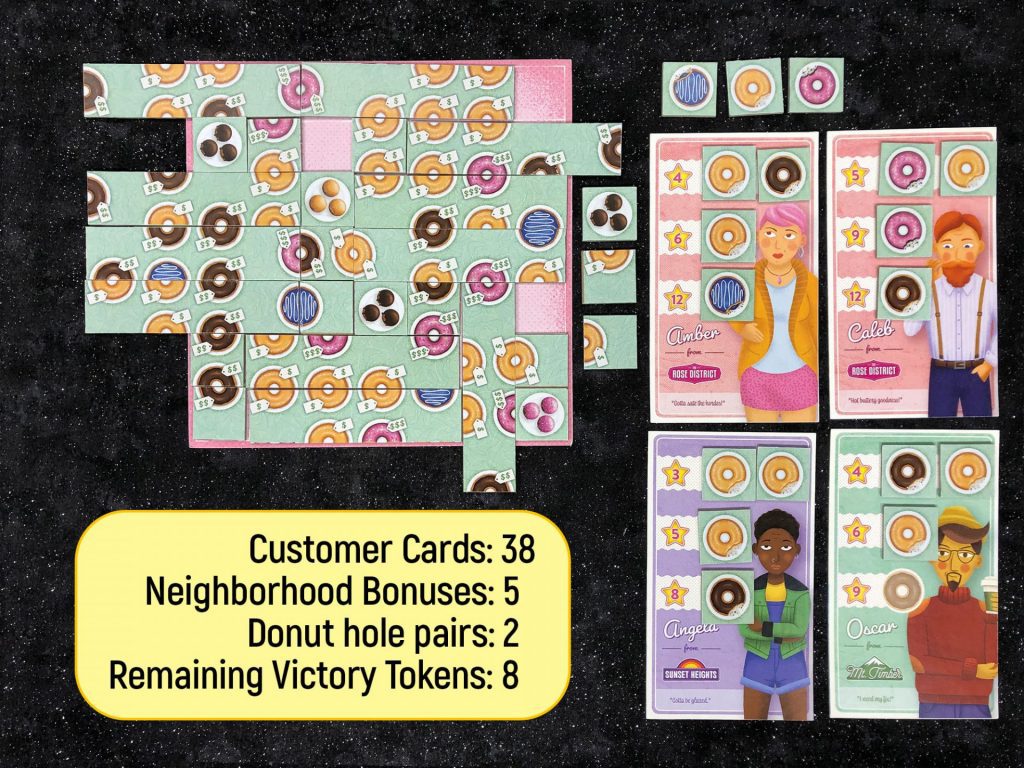
Final Thoughts & Favorite Donuts
My Favorite Donuts
- Plain glazed yeast
- Raspberry filled
- Shredded coconut glazed
- Lemon filled
- Blueberry glazed cake
One of my favorite things about their games is that they like playing with unexplored themes. Games about quilting, salads, fishing and marketing your catch, and donuts? What a great mix! Plus the way their games are put together is usually very appealing. I’m happy to say that Dollars to Donuts maintains the tradition.
If you’ve read any of my other reviews you’ll know that I fall squarely in the lighter end of the gaming scale and it’s nice to find a game this well-crafted and honed that fits my preferences. Tile laying is one of my favorite types of games; I really enjoy the puzzly aspect of picking the right tile and placing it into the perfect location. And Dollars to Donuts does that for me. Because the game also rewards you for donuts which are mismatched you can score Victory Tokens AND Dollar tiles in a single placement, and if you’ve got good draws from the bag then you can multiply your earnings by placing a Dollar Tile onto the board to earn even more donuts.
I love that serving customers earns you more points than just making pastries. After all, having the perfect donut is meaningless without someone to enjoy it. And asking players to also focus on neighborhoods is a great addition; although that can bite you if the card draws don’t go your way. I also love the broad diversity in customer illustrations: black, white, latinx, asian – it makes sense because everyone loves donuts.
Many board games go for a more illustrative approach to their artwork; it’s clear that you’re looking at something drawn. But with the exception of the customer artwork, Dollars to Donuts went hyper-realistic. You can see bites taken out of some of the donuts, if you look closely you can distinguish individual sprinkles; it all serves to immerse you in the theme of the game.
Everything about Dollars to Donuts says artisanal; this isn’t some donut store chain game, no! Even though the Flatout Games crew (Molly Johnson, Robert Melvin, Shawn Stankewich) along with intern Tim Horton are still relatively new designers, I expect them to continue to hone their craft and produce more Krispy treats just like Dollars to Donuts. There’s no Voodoo here; just solid gameplay, great design, and artwork real enough to make me want a coffee for Dunkin’ while I’m playing. Dollars to Donuts is live on Kickstarter right now, you should definitely go check it out.
I might just sneak out to grab a dozen while I wait.
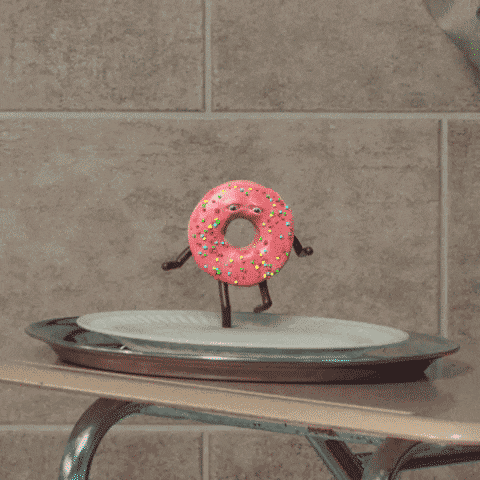


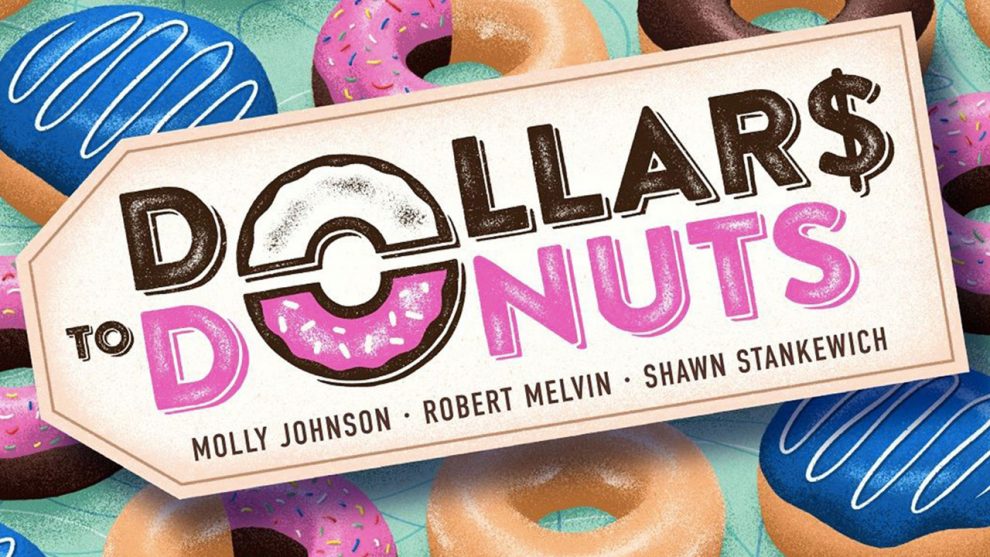



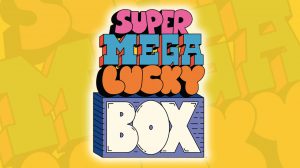




Add Comment